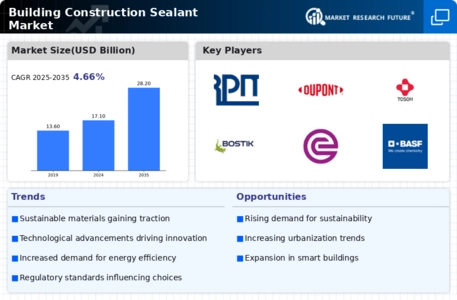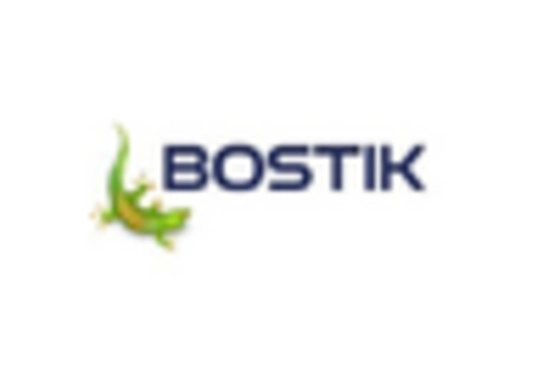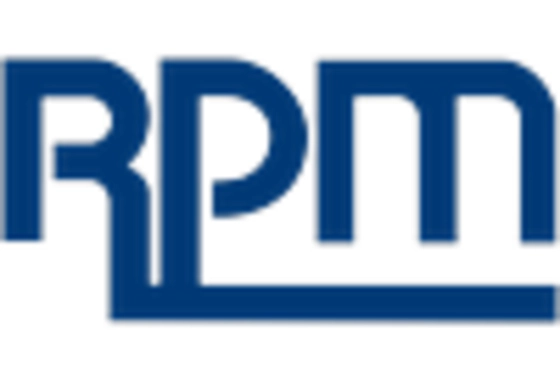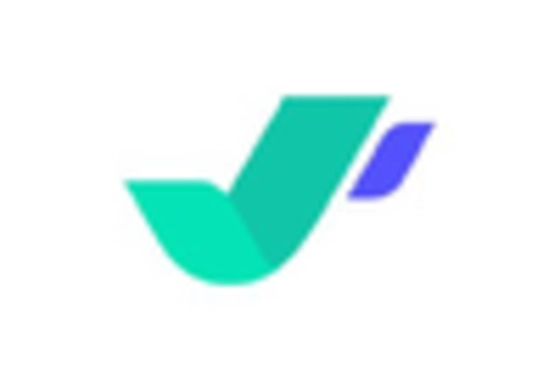Rising Construction Activities
The Building Construction Sealant Market is experiencing a surge in demand due to increasing construction activities across various sectors. Urbanization and population growth are driving the need for new residential, commercial, and industrial buildings. According to recent data, construction spending has shown a steady increase, with projections indicating a compound annual growth rate of approximately 5% over the next few years. This growth in construction activities necessitates the use of sealants for waterproofing, insulation, and aesthetic purposes, thereby propelling the market forward. As builders and contractors seek to enhance the durability and energy efficiency of structures, the demand for high-performance sealants is likely to rise, further stimulating the Building Construction Sealant Market.
Innovations in Sealant Technology
Technological advancements are playing a pivotal role in shaping the Building Construction Sealant Market. Innovations such as the development of advanced polymer-based sealants and eco-friendly formulations are gaining traction. These new products offer superior adhesion, flexibility, and resistance to environmental factors, which are essential for modern construction needs. Market data suggests that the introduction of smart sealants, which can change properties in response to environmental conditions, is on the horizon. Such innovations not only improve the performance of sealants but also align with sustainability goals, making them attractive to builders and architects. As a result, the Building Construction Sealant Market is likely to witness a shift towards these advanced solutions, enhancing overall market growth.
Regulatory Standards and Compliance
The Building Construction Sealant Market is also shaped by stringent regulatory standards and compliance requirements. Governments and regulatory bodies are increasingly implementing guidelines that mandate the use of specific sealant types to ensure safety, durability, and environmental protection. Compliance with these regulations is essential for construction companies to avoid penalties and ensure project approvals. As a result, there is a growing demand for sealants that meet these regulatory standards, which is likely to drive innovation and product development within the market. Furthermore, adherence to these regulations can enhance the reputation of construction firms, making compliance a key driver in the Building Construction Sealant Market.
Increased Focus on Energy Efficiency
The Building Construction Sealant Market is significantly influenced by the growing emphasis on energy efficiency in construction. As energy costs continue to rise, builders are increasingly adopting materials and practices that enhance thermal performance and reduce energy consumption. Sealants play a crucial role in achieving these objectives by minimizing air leaks and improving insulation. Recent studies indicate that buildings utilizing high-quality sealants can achieve energy savings of up to 30%. This trend is further supported by government initiatives promoting energy-efficient building practices, which are likely to drive demand for sealants that meet stringent energy performance standards. Consequently, the Building Construction Sealant Market is poised for growth as energy efficiency becomes a priority in construction projects.
Growing Renovation and Retrofitting Activities
The Building Construction Sealant Market is witnessing a notable increase in renovation and retrofitting activities. As existing structures age, there is a rising need for maintenance and upgrades to improve functionality and aesthetics. Sealants are essential in these projects for sealing joints, preventing moisture ingress, and enhancing energy efficiency. Market analysis indicates that the renovation sector is expected to grow at a rate of 4% annually, driven by factors such as urban renewal and the desire for sustainable living spaces. This trend not only boosts the demand for sealants but also encourages the development of specialized products tailored for renovation applications. Thus, the Building Construction Sealant Market stands to benefit significantly from the ongoing renovation and retrofitting boom.


















Leave a Comment